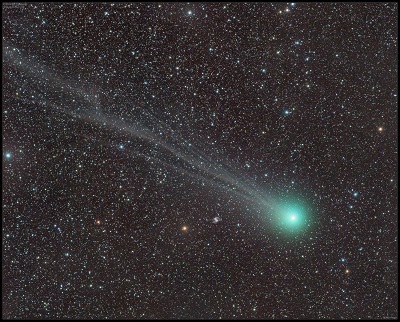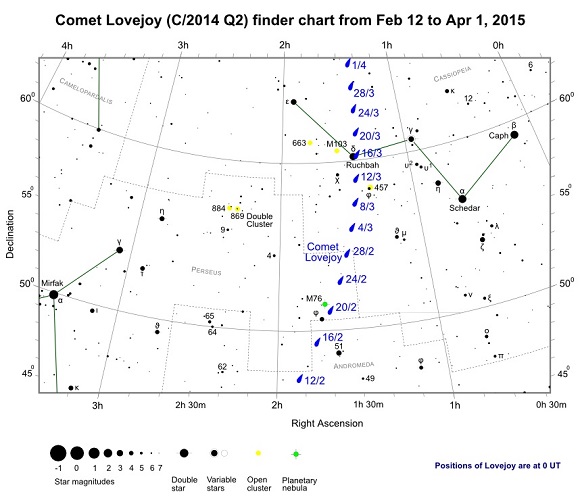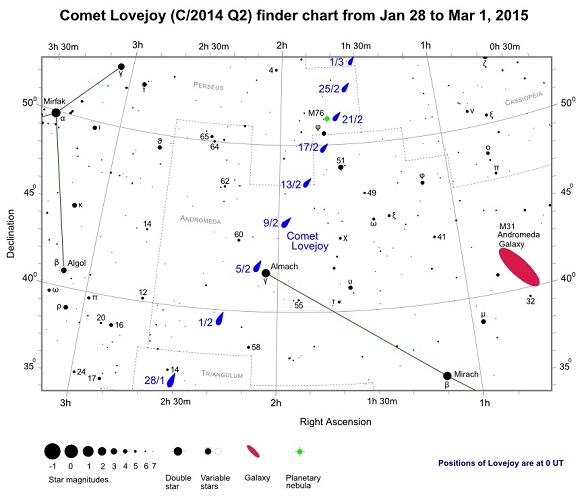As it heads towards the outer depths of the Solar System, comet Lovejoy remains visible with small telescopes and even good binoculars during March. Although now fading and past its best the comet has been a delight over recent months and should remain well within amateur astronomer range for some time to come. For a number of days in late December / early January it even was visible to the naked eye (peak mag. +3.9).
Lovejoy was the fifth comet to be discovered by prolific Australian comet hunter and amateur astronomer Terry Lovejoy. He captured it on August 17, 2014 using nothing more than a 200mm (8-inch) scope with a digital camera attached. The subsequent set of time-lapsed images revealed nothing just a faint point of light (mag. +15) that moved slightly from image to image.

Location and star chart
Comet Lovejoy is now very much a Northern Hemisphere object as it continues to move in the direction of the North Celestial Pole. It spends the end of February in Perseus before crossing into Cassiopeia on the last day of the month. Magnitudes of comets are notoriously difficult to predict but we estimate on March 1st it will shine at +6.0 and therefore at the limit of naked eye visibility but easily seen with binoculars and small telescopes. For those located at southern temperate latitudes the comet is too far north to be seen at all.
From latitudes of at least 35 degrees north Lovejoy never sets during March and is visible all night. It's best seen during the middle two "Moonless" weeks of the month. Highlights include on March 10th when the comet passes 1 degree east of the brightest open cluster in Cassiopeia, NGC 457 the Owl Cluster (mag. +6.4). At magnitude +6.5, Lovejoy is fractionally fainter than the splendid open cluster. A few days later on March 16th it passes 0.1 degrees west of Ruchbah (δ Cas - mag +2.7). As the comet is expected to be more than 4 magnitudes fainter than the star it will probably be difficult to spot against the bright stellar glare. However, it should be easier to see over the next few evenings when it passes just west of two more bright open clusters, M103 (mag. +7.4) and NGC 663 (mag. +7.1). At closest separation Lovejoy is 1 degree from M103 and 3 degrees from NGC 663. It should be noted that Messier Catalogue hunters often mistakenly identify NGC 663 as M103!
The finder charts below show the positions of the comet from January 28th to April 1st, 2015.

Comet Lovejoy (C/2014 Q2) Finder Chart from February 12th to April 1st, 2015 - pdf format

Comet Lovejoy (C/2014 Q2) Finder Chart from January 28th to March 1, 2015 - pdf format
C/2014 Q2 (Lovejoy) Data (at epoch December 9, 2014)
| Name | C/2014 Q2 (Lovejoy) |
|---|---|
| Type | Comet |
| Discoverer | Terry Lovejoy |
| Discovery date | August 17, 2014 |
| Perihelion (AU) | 1.29077 |
| Eccentricity | 0.99809 |
| Orbital period (years) | ~8000 |
| Inclination (degrees) | 80.3021 |
| Longitude of ascending node (degrees) | 94.9937 |
| Perihelion | January 30th, 2015 |
Comet (C2014/Q2) Lovejoy Data Table
| Date | Right Ascension | Declination | Mag. | Distance from Earth (AU) | Constellation |
|---|---|---|---|---|---|
| February 25, 2015 | 01h 35m 15s | 53d 13m 24s | +5.7 | 1.232 | Perseus |
| February 26, 2015 | 01h 34m 20s | 53d 37m 41s | +5.8 | 1.250 | Perseus |
| February 27, 2015 | 01h 33m 28s | 54d 01m 34s | +5.8 | 1.269 | Perseus |
| February 28, 2015 | 01h 32m 39s | 54d 25m 05s | +5.9 | 1.287 | Perseus |
| March 01, 2015 | 01h 31m 52s | 54d 48m 16s | +6.0 | 1.304 | Cassiopeia |
| March 02, 2015 | 01h 31m 08s | 55d 11m 09s | +6.0 | 1.322 | Cassiopeia |
| March 03, 2015 | 01h 30m 27s | 55d 33m 44s | +6.1 | 1.340 | Cassiopeia |
| March 04, 2015 | 01h 29m 48s | 55d 56m 04s | +6.1 | 1.357 | Cassiopeia |
| March 05, 2015 | 01h 29m 11s | 56d 18m 09s | +6.2 | 1.375 | Cassiopeia |
| March 06, 2015 | 01h 28m 37s | 56d 40m 01s | +6.3 | 1.392 | Cassiopeia |
| March 07, 2015 | 01h 28m 05s | 57d 01m 41s | +6.3 | 1.409 | Cassiopeia |
| March 08, 2015 | 01h 27m 34s | 57d 23m 10s | +6.4 | 1.426 | Cassiopeia |
| March 09, 2015 | 01h 27m 06s | 57d 44m 30s | +6.4 | 1.442 | Cassiopeia |
| March 10, 2015 | 01h 26m 40s | 58d 05m 40s | +6.5 | 1.459 | Cassiopeia |
| March 11, 2015 | 01h 26m 16s | 58d 26m 43s | +6.6 | 1.475 | Cassiopeia |
| March 12, 2015 | 01h 25m 54s | 58d 47m 39s | +6.6 | 1.491 | Cassiopeia |
| March 13, 2015 | 01h 25m 33s | 59d 08m 29s | +6.7 | 1.507 | Cassiopeia |
| March 14, 2015 | 01h 25m 14s | 59d 29m 14s | +6.7 | 1.523 | Cassiopeia |
| March 15, 2015 | 01h 24m 57s | 59d 49m 54s | +6.8 | 1.538 | Cassiopeia |
| March 16, 2015 | 01h 24m 42s | 60d 10m 31s | +6.9 | 1.554 | Cassiopeia |
| March 17, 2015 | 01h 24m 28s | 60d 31m 05s | +6.9 | 1.569 | Cassiopeia |
| March 18, 2015 | 01h 24m 16s | 60d 51m 36s | +7.0 | 1.584 | Cassiopeia |
| March 19, 2015 | 01h 24m 05s | 61d 12m 06s | +7.0 | 1.599 | Cassiopeia |
| March 20, 2015 | 01h 23m 56s | 61d 32m 35s | +7.1 | 1.614 | Cassiopeia |
| March 21, 2015 | 01h 23m 48s | 61d 53m 04s | +7.2 | 1.628 | Cassiopeia |
| March 22, 2015 | 01h 23m 41s | 62d 13m 33s | +7.2 | 1.643 | Cassiopeia |
| March 23, 2015 | 01h 23m 36s | 62d 34m 03s | +7.3 | 1.657 | Cassiopeia |
| March 24, 2015 | 01h 23m 32s | 62d 54m 34s | +7.3 | 1.671 | Cassiopeia |
| March 25, 2015 | 01h 23m 29s | 63d 15m 06s | +7.4 | 1.685 | Cassiopeia |
| March 26, 2015 | 01h 23m 27s | 63d 35m 40s | +7.5 | 1.698 | Cassiopeia |
| March 27, 2015 | 01h 23m 26s | 63d 56m 17s | +7.5 | 1.712 | Cassiopeia |
| March 28, 2015 | 01h 23m 26s | 64d 16m 56s | +7.6 | 1.725 | Cassiopeia |
| March 29, 2015 | 01h 23m 27s | 64d 37m 39s | +7.6 | 1.738 | Cassiopeia |
| March 30, 2015 | 01h 23m 30s | 64d 58m 24s | +7.7 | 1.751 | Cassiopeia |
| March 31, 2015 | 01h 23m 33s | 65d 19m 14s | +7.7 | 1.764 | Cassiopeia |
| April 01, 2015 | 01h 23m 37s | 65d 40m 08s | +7.8 | 1.777 | Cassiopeia |
See also
Comet Lovejoy (C/2014 Q2) remains visible with binoculars and small telescopes during February 2015
How to see Comet Lovejoy (C/2014 Q2) during January 2015
Comet Lovejoy (C/2014 Q2) a naked eye comet for the New Year
Comet Lovejoy (C/2014 Q2) now visible with binoculars from Southern latitudes